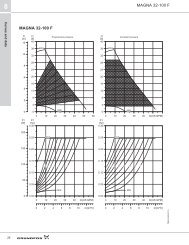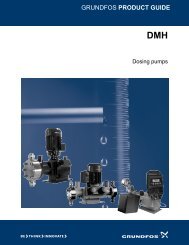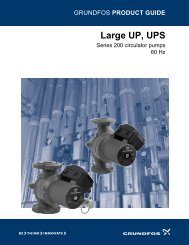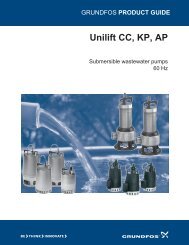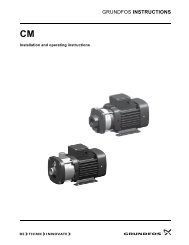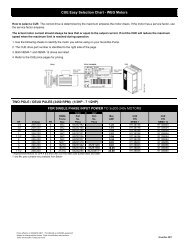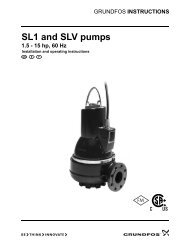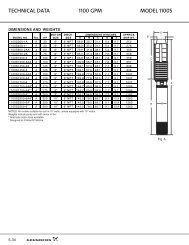CR, CRI, CRN, CRE, CRIE, CRNE - Grundfos Canada
CR, CRI, CRN, CRE, CRIE, CRNE - Grundfos Canada
CR, CRI, CRN, CRE, CRIE, CRNE - Grundfos Canada
You also want an ePaper? Increase the reach of your titles
YUMPU automatically turns print PDFs into web optimized ePapers that Google loves.
Pumped liquids<br />
<strong>CR</strong>, <strong>CR</strong>I, <strong>CR</strong>N, <strong>CR</strong>E, <strong>CR</strong>IE, <strong>CR</strong>NE<br />
Pumped liquids<br />
Thin, non-explosive liquids, not containing solid<br />
particles or fibers. The liquid must not chemically attack<br />
the pump materials. When pumping liquids with a<br />
density and/or viscosity higher than that of water,<br />
oversized motors must be used, if required.<br />
Whether a pump is suitable for a particular liquid<br />
depends on a number of factors of which the most<br />
important are the chloride content, pH value,<br />
temperature and content of chemicals, oils, etc.<br />
Please note that aggressive liquids (e.g. sea water and<br />
some acids) may attack or dissolve the protective oxide<br />
film of the stainless steel and thus cause corrosion. The<br />
<strong>CR</strong>(E), <strong>CR</strong>I(E), <strong>CR</strong>N(E) pump types are suitable for the<br />
following liquids:<br />
<strong>CR</strong>(E), <strong>CR</strong>I(E)<br />
• Non-corrosive liquids.<br />
For liquid transfer, circulation and pressure boosting of<br />
cold or hot clean water.<br />
<strong>CR</strong>N(E)<br />
• Industrial liquids.<br />
In systems where all parts in contact with the liquid<br />
must be made of high-grade stainless steel.<br />
<strong>CR</strong>T(E)<br />
• Saline liquids.<br />
• Hypochlorites.<br />
• Acids.<br />
For saline or chloride-containing liquids such as sea<br />
water or oxidizing agents such as hypochlorites,<br />
<strong>CR</strong>T(E) pumps of titanium are available. See separate<br />
product guide on <strong>CR</strong>T(E).<br />
List of pumped liquids<br />
A number of typical liquids are listed on the following<br />
pages.<br />
Other pump versions may be applicable, but those<br />
stated in the list are considered to be the best choices.<br />
The table is intended as a general guide only, and<br />
cannot replace actual testing of the pumped liquids and<br />
pump materials under specific working conditions.<br />
The list should, however, be applied with some caution<br />
as factors such as<br />
• concentration of the pumped liquid,<br />
• liquid temperature or<br />
• pressure<br />
may affect the chemical resistance of a specific pump<br />
version.<br />
Safety precautions must be made when pumping<br />
dangerous liquids.<br />
Notes<br />
D Often with additives.<br />
Density and/or viscosity differ from that of water.<br />
E Allow for this when calculating motor output and pump<br />
performance.<br />
Pump selection depends on many factors.<br />
F<br />
Contact <strong>Grundfos</strong>.<br />
H Risk of crystallization/precipitation in shaft seal<br />
1 The pumped liquid highly inflammable.<br />
2 The pumped liquid is combustible.<br />
3 Insoluble in water.<br />
4 Low self-ignition point.<br />
74



